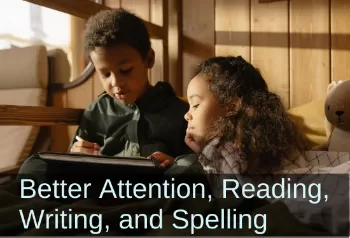Primitive Reflex Integration Case Studies
OT “Filled with Gratitude and Excitement”; Sees Profound Results for 6-Year-Old Boy
Neurodevelopmental movements: Help for reading, writing, attention, and speech.
Rhythmic movements and primitive reflex integration helped this 6-year-old boy improve many aspects of learning. Find out how this boy's spelling tests went from 64% to 100%. This case study shows how profound the effects of neurodevelopmental movements can be!
Submitted by Briana Dannecker, MS, OTR/L

| Before | After |
|---|---|
| Deficits related to reading | Improved reading comprehension |
| Difficulties in school | Improved scores on assignments and exams |
| Inconsistent hand dominance | Demonstrates consistent right-hand dominance |
| Difficulties with handwriting | Improved formation, sizing, spacing, line placement, and directionality of uppercase letters |
| Inappropriate handwriting grasp | Utilizing an age-appropriate dynamic tripod grasp on writing tools |
| Often fixated on dislike, discomfort, or fatigue when writing | Increased motivation and stamina when writing, completing these tasks in less time with fewer breaks |
| Deficits related to attention | Improved attention span during all therapeutic tasks, including previously non-preferred activities |
| Poor eye contact | Improved eye contact |
| Poor conversational skills | Improved conversational skills |
C.T. is a 6-year-old boy that was exhibiting deficits related to attention, social interaction, fine manual control associated with grasp, manipulation, precision, strength, hand dominance, and bilateral coordination, visual perceptual/visual motor skills, handwriting, spelling, reading, math, sensory processing, and motor planning/gross coordination.
I chose to begin by using the Brain Tune-Up prior to non-preferred activities, specifically handwriting tasks, because C.T. often fixated on his dislike, discomfort, or fatigue rather than focusing on the task at hand. I quickly observed increased motivation and stamina when the Brain Tune-up was utilized; C.T. was completing these tasks in a shorter amount of time with fewer breaks provided.
Two weeks following implementation of the Brain Tune-up, C.T.’s mother joined us in his therapy session to learn passive Rhythmic Movements [from the Brain and Sensory Foundations course]. The caregiver education session took place on 10/15/2020, approximately 3 months ago. The very night of parent education, his mother reached out to tell me that C.T. had spelled 7/9 words correctly on his practice quiz, which was very rare. The next morning, C.T. did two of the rhythmic movements prior to leaving for school. He earned an A+ on the spelling test, spelling all words correctly, even the bonus word. His mother reported that he had gotten a 64 or lower on all previous spelling tests.
C.T.’s caregiver is excellent with consistent carryover of rhythmic movements. I can see that C.T. is steadily becoming more coordinated with active facilitation, indicating brain maturity, and has also demonstrated improved self-advocacy for speed and duration of movements. I have begun to implement reflex integration work [from the Brain and Sensory Foundations® course] into our sessions together, as he exhibits an unintegrated TLR [Tonic Labyrinthine Reflex], ATNR [Asymmetrical Tonic Neck Reflex], FPR [Fear Paralysis Reflex], Moro [Reflex], Spinal Galant [Reflex], and hand reflexes.
Following consistent carryover of Rhythmic Movements, his mother reported improved reading comprehension and phonological awareness with improved scores on assignments and exams in school. C.T. now demonstrates consistent right-hand dominance while utilizing an age-appropriate dynamic tripod grasp on his writing tools.
He has displayed improved formation, sizing, spacing, line placement, and directionality of uppercase letters. C.T.’s mother often says, “His handwriting is better than mine!”. He demonstrates an improved attention span during all therapeutic tasks, including previously non-preferred activities. Therapists who have interacted with C.T. in the past spontaneously remark on his improved eye contact and conversational skills.
From this client’s experience with a neurodevelopmental program, I learned how profound Rhythmic Movements alone can be. I am truly filled with gratitude and excitement for continued reflex integration work in addition to sustained implementation of rhythmic movements.
[Edited for length and clarity; emphasis added]
*Disclaimer: The activities in the Brain and Sensory Foundations curriculum make use of the natural processes of neuroplasticity and development that are innately wired in the design of human beings to promote maturity and function. These activities appear to calm, organize, and mature the neuro-sensory-motor systems just as we see in the healthy development of human infants. Individual results may vary, and we do not claim to offer a diagnosis or cure for any specific condition or disorder. The Brain and Sensory Foundations activities appear to improve overall functioning resulting in measurable improvements for a range of conditions as demonstrated in over 1800 case studies from participants.

